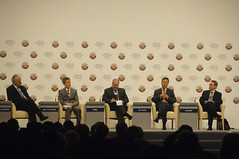| Image by World Economic Forum via Flickr |
Corporate Sustainability in Africa 2012 – Living in the Water, Food and Energy Nexus
21st to the 25th May 2012
“The world is home to 7 billion people, but how far have we come?”
Babatunde Osotimehin – Under-Secretary General @ UN & Executive Director @ United Nations Population Fund
The next question to ask is – What Now?
The “water-food-energy” nexus: A rapidly rising global population and growing prosperity are putting unsustainable pressures on resources. Demand for water, food and energy is expected to rise by 30-50% in the next two decades, while economic disparities incentivize short-term responses in production and consumption that undermine long-term sustainability. Shortages could cause social and political instability, geopolitical conflict and irreparable environmental damage. Any strategy that focuses on one part of the water-food-energy nexus without considering its interconnections risks serious unintended consequences.
World Economic Forum – Global Risks 2011 – Sixth Edition – An initiative of the Risk Response Network
The Water-Food-Energy nexus, a term developed by the World Economic Forum in its Global Risks 2011 series, refers to the risks of water security, food security and energy security.
Facts about the Water-Food-Energy Nexus
Agriculture is the dominant water user, consuming more than 70% of total global water demand. Industrially produced meat is especially water intensive, requiring up to 20,000 litres of water to produce a kilogram, compared to approximately 1,200 litres to produce a kilogram of grain.
Both population growth and increasing meat consumption in emerging economies will therefore have a tremendous impact on resource needs.
Over the next 10 years, the world population is expected to rise to approximately 7.7 billion, with most of the growth in emerging economies. The United Nations Food and Agriculture Organization (FAO) projects a 50% increase in demand for food by 2030, and the International Food Policy Research Institute (IFRI) expects a 30% increase in demand for water, with other estimates rising to over 40%. The International Energy Agency (IEA) forecasts that the world economy will demand at least 40% more energy by 2030; producing this energy will draw heavily on freshwater resources.
For such increased demand for water, food and energy to be realized, significant and perhaps radical changes in water use will be required as well as new sources for food and energy production will need to be explored. For food production, supply-related challenges may limit the ability of farmers to meet growth in demand. Already, major grain-producing areas – in China, India and the United States, for example – depend on unsustainable mining of groundwater.
In some regions, such as North Africa and Australia, climate-related changes of precipitation have already critically reduced the levels of freshwater supply. In northeast China, one of the country’s main grain-producing regions, climate change could increase drought losses by over 50% by 2030.
Climate change is likely to be exacerbated by meeting the growing demand for energy. Over 75% of the global increase in energy use from 2007-2030 is expected to be met through fossil fuels, especially coal, and an estimated 77% of the power stations required to meet demand are yet to be built.
Water security, food security and energy security are chronic impediments to economic growth and social stability. Food production requires water and energy; water extraction and distribution requires energy; and energy production requires water. Food prices are also highly sensitive to the cost of energy inputs through fertilizers, irrigation, and transport and processing. Economic growth and population growth are common drivers for all three risks, especially as improving living conditions in emerging economies results in more resource-intensive consumption patterns.
Environmental pressures also drive resource insecurity – from climate shifts to extreme weather events that alter rainfall and affect crop production. Governance failures in terms of managing shared resources – such as trans-boundary water and energy sources and food trade agreements – create tensions that can lead to conflict, as seen recently in Yemen.
Economic disparity also often exacerbates this nexus of risks as governments and consumers seek short-term, unsustainable solutions to economic hardship such as growing high-value, water-intensive export crops in water-deprived regions. It is at the local level that most opportunities can be found for improving resource efficiency and managing trade-offs between energy, water and food production.
The conference objectives:-
This conference aims to provide a platform for business to communicate directly with local, regional and global experts who are already immersed in the Water, Food, Energy Nexus. Unfortunately events such as the World Economic Forum tend to largely exclude mainstream business, additionally most events that deal with Security (Water/Food or Water/Energy or any other combination of the three) tend to be run by government and NGO Lobby groups which also more often than not exclude mainstream business. The Water Food Energy Nexus is a global risk that will touch every person on this planet sooner or later. This conference aims to highlight the seriousness of the problem and explore potential solutions and strategies to mitigate and minimize the risks.
The speakers approached for the conference are subject matter experts from both Public and Private Sector and also Lobby and interest groups. Many of the experts approached have already come out publically on the need to the global effort to be increased. Vital Training is of the belief that this conference has the capacity to go beyond the global industry leaders and into the business trenches.












